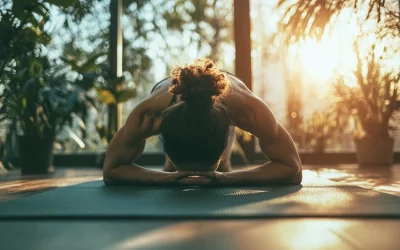For many people, the words “stretching” and “yoga” seem interchangeable. You do stretches in yoga, so why are they classified as two different things? As similar, as they are, there are numerous differences between stretching and yoga.
Similarities between the two.
There are several similarities between stretching and yoga. They both are types of movement that encourage full-body movement and flexibility. The poses are restorative and can help you build basic muscle strength. Both stretching and yoga improve your balance and posture and can help you work out any sore muscles.
Stretching and yoga are often recommended alongside many physical ailments, as an alternative to medicine for pain, and have been shown to help regulate blood sugar levels in diabetics.
So what makes yoga different?
Yoga is a mindful movement practice, originating over 5,000 years ago. It combines mind and body with the elements of breathing, balance, and focus. Yoga is a complete workout, one that can be done by nearly anyone.
There are many types of yoga, from “hot” yoga, to focusing on posture, to meditative practice. There is not one “right” type of yoga- they all serve different purposes. While yoga is most associated with Hinduism, there are also a variety of yoga schools in Buddhism and Jainism as well.
Yoga is typically done in classes, with an emphasis on flow. There is a wonderful sense of community and connection in each class. If you would like to do yoga at home, check out Yoga with Adriene on YouTube.
With yoga, however, many people have to be cautious starting out. There are several poses (such as the one below) that are not obtainable to beginners. “Beginner” classes aren’t always suited to true beginners, people who don’t regularly exercise, or those with physical limitations.
Yoga is still a great practice and physical activity but check in with your body as you move. Be conscious of any sensations of pain or discomfort and respond accordingly.
What is the difference between yoga and stretching?
While yoga is typically a complete workout or flow session, stretching can be stand-alone poses or a workout. This allows stretching to be more flexible around your daily schedule. You don’t need a specific course or a solid forty minutes to move. You can squeeze in a few 5–10 minute sessions a day and not disrupt your daily schedule.
Stretching, especially with WeStretch, is a great exercise for everyone. It doesn’t matter if you are a true beginner or a professional athlete- everyone can benefit from stretching.
When starting out, Ada purposefully guides you through stretches that you may feel are too easy. You’re still getting the benefits of stretching, but her physiotherapist-approved stretches are designed not to hurt you.
Stretching and yoga work well together.
One modality is not better than the other, but they complement each other nicely. Yoga does different poses and motions than stretching and vice versa. While some poses may overlap, both forms of exercise get your body moving and feeling great.
Maria, one of our stretchers who also teaches yoga and competes on the world stage for Irish dance, says that stretching and yoga are on opposite ends of the spectrum. She has incorporated different stretches into her yoga classes, and she uses the mindful movement of yoga to enhance her stretching practices.
Incorporating stretching and yoga into your day.
Yoga poses are a great way to start or end your day. If you are able to wake up earlier and give yourself at least a good twenty minutes or so, yoga may be perfect for you. It allows you to gradually wake up and centre yourself for the day.
For night owls, doing gentle yoga before bed is a great option for a nighttime routine. This is a great wind-down without technology before bed, improving your sleep!
Stretching is a great option to squeeze in your day if you only have a few spare minutes at a time.
If you get up a little later than you would like but want that physical activity in the morning. Do a few minutes of stretching while you brush your teeth. Take a stretch break at work, or as a wind-down before bed.
Little moments of movement are better than nothing!
The best way to build your stretching (or yoga) habit, though, is to be consistent. Set aside a regular time of day, every day. Choose a consistent length to stretch and be persistent until stretching is second nature. You can always do more than this, but by building this foundation, you are more likely to achieve success!
Adding music to your workouts.
Music can be a great element to any workout. It can help you focus, relax deeper into your stretches, or push harder when running. Incorporate listening to music into your exercises to enhance your overall experience.
Since yoga is about focus and peace, it’s often best to find soothing music, like acoustic guitar covers of your favourite songs or a spa playlist. While classical music seems like it should be soothing, the complexity can activate your brain. This can prevent you from focusing on your breathing and movement.
Stretching offers a bit more flexibility with what to listen to. Depending on what your goal of stretching at that moment is, you could listen to soothing music to help you unwind or high-intensity hits to keep you motivated. Whatever help you best enjoy your stretching session.
Add movement to your day, regardless of what it is.
At the end of the day, it doesn’t matter what you do for exercise. While doing a variety of activities is recommended, ultimately, any movement is better than none.
If doing a 5-minute stretch gets you off the couch, then that is wonderful! If you have a chance to do yoga with a loved one, either virtually or in person: amazing! Find what works for you and incorporate it into your life.
Start stretching today by downloading WeStretch from the App Store or Google Play.
Any links included are for reference, additional information, or entertainment value only, without monetary compensation. Contact us on social media or at [email protected]. Photos courtesy of Unsplash.
This article is not intended to act as or replace medical advice. Please talk to your healthcare practitioner if you have any concerns.
Written by Kayla Willsey
Updated June 2, 2021






